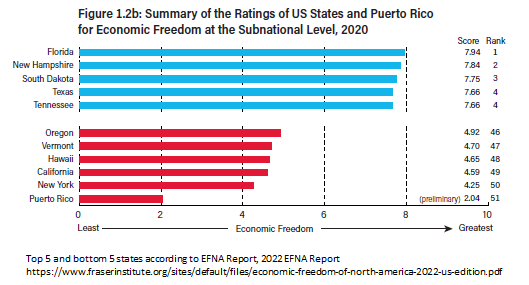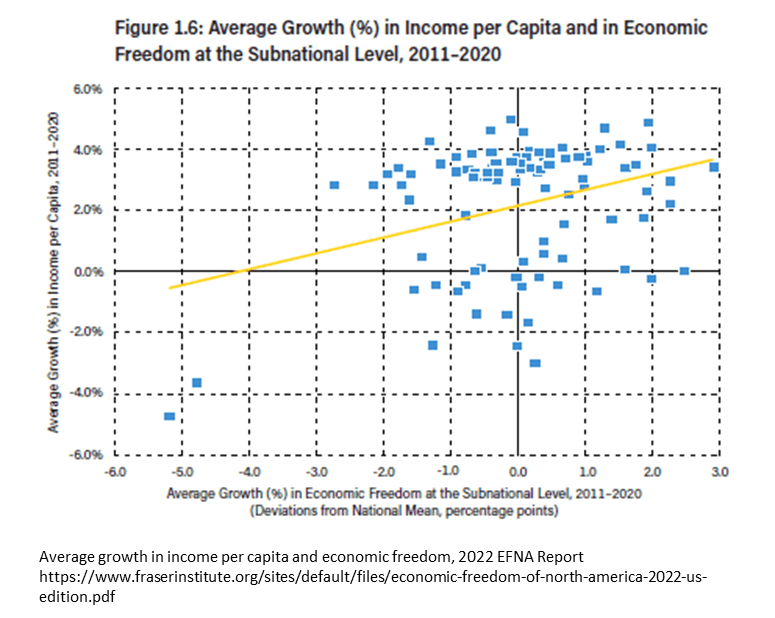
Tampa, Florida, USA downtown city skyline over the Hillsborough River. GETTY
Economic freedom is vital for economic growth. If government makes it difficult for people to start businesses, choose their own work arrangements, or invest in companies, economic growth will stagnate. According to a new study, Puerto Rico, New York, and California provide the least economic freedom to their residents while Florida, New Hampshire, and South Dakota provide the most.
For the last 18 years, the Fraser Institute has ranked the 50 U.S. states and the provinces of Canada and Mexico based on “the extent to which the policies of individual provinces and states were supportive of economic freedom, the ability of individuals to act in the economic sphere free of undue restrictions.”
This year, the top five states in the Economic Freedom of North America (EFNA) report are Florida, New Hampshire, South Dakota, Texas, and Tennessee. New York is the lowest ranked state, followed by California, Hawaii, Vermont, and Oregon. Puerto Rico is ranked last, but it is a territory, not a state. (See figure below).


A substantial amount of research finds that more state economic freedom is associated with faster economic growth, less unemployment, higher per capita incomes, more entrepreneurial activity, and more population growth. In this year’s report, the authors also show that states and provinces that increase economic freedom experience faster per capita income growth on average (see figure below).


There are several things states and territories can do to increase economic freedom. Tax reforms that lower income tax rates and decrease the burden of other taxes that discourage investment, such as corporate tax rates, increase economic freedom by allowing people to keep more of what they earn to use as they see fit.
New Hampshire, which ranks second on the EFNA index, has no income tax and recently cut business taxes to encourage investment. States that want to boost economic freedom should follow its lead.
Too much regulation also decreases economic freedom. According to the Mercatus Center at George Mason University, California and New York are two of the most regulated states in the country. Meanwhile, South Dakota, New Hampshire, Tennessee, and Florida have relatively low levels of regulation. It is no surprise that California and New York have low levels of economic freedom while the latter four states are in the top five most free.
States that want to decrease their regulatory burdens to increase economic freedom have several options, including red-tape reduction rules, sunset provisions, and improving their economic analysis to prevent the most damaging rules from being implemented.
State governments should also scrutinize their spending. A high level of government spending crowds out economic activity by shifting resources—workers, materials, land—and tax dollars away from individuals in the market into the hands of politicians and bureaucrats. There is a role for government in the market—providing true public goods, upholding the rule of law, maintaining a basic safety net—but too much government spending can drive inflation, decrease the incentive to work, and slow innovation by undermining risk taking and entrepreneurship. State governments that spend money efficiently and focus on core activities create more room for individuals to thrive in the private sector.
Economic freedom is an important driver of economic progress. America’s economic success is in large part a result of the high degree of freedom enjoyed by our workers, investors, and entrepreneurs. Economic freedom is similarly important at the state level, and the annual EFNA report is a great reminder of that. While Florida, New Hampshire, and South Dakota are already relatively free, there is always room for improvement. Hopefully next year’s report shows substantial improvements in economic freedom nationwide.
This article was originally published in in Forbes.

